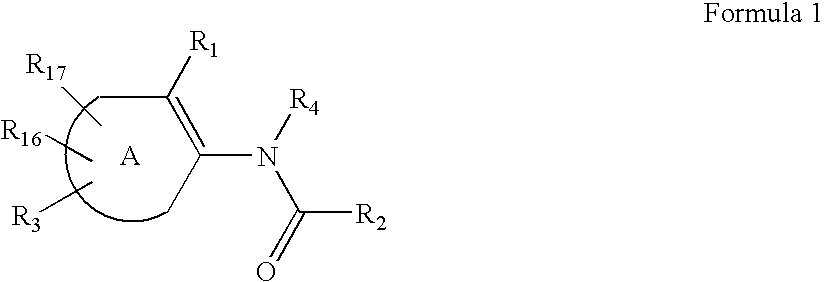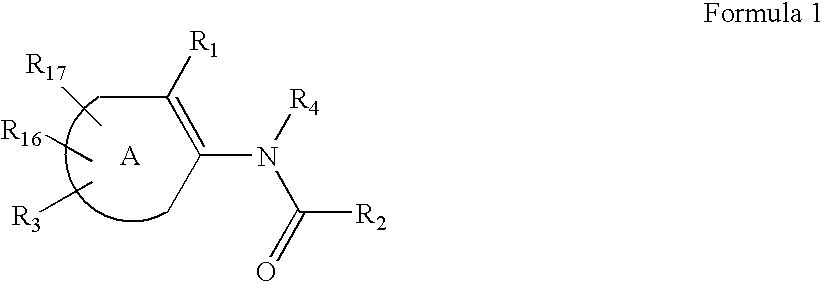Substituted thiophene compounds as modulators of protein tyrosine phosphatases (PTPases)
a technology of protein tyrosine phosphatase and thiophene compounds, which is applied in the field of compounding, can solve the problems of cellular transformation, diabetes mellitus, and a more complex picture of the function of ptpases
- Summary
- Abstract
- Description
- Claims
- Application Information
AI Technical Summary
Problems solved by technology
Method used
Image
Examples
example 1
[0326]
2-Methyl4-(oxalyl-amino)-1H-pyrrole-3-carboxylic acid:
[0327] To a stirred solution of 4-(methoxyoxalyl-amino)-2-methyl-1H-pyrrole-3-carboxylic acid tert-butyl ester (2.0 g, 7.09 mmol) in dichloromethane (20 ml) was added trifluoro acetic acid (10 ml). The resulting reaction mixture was stirred at room temperature for 2 h. The volatiles were evaporated in vacuo affording 1.6 g (100%) of 4-(methoxyoxalyl-amino)-2-methyl-1H-pyrrole-3-carboxylic acid as a solid.
[0328] To a solution of the above pyrrole-3-carboxylic acid (1.2 g, 5.31 mmol) in ethanol (100 ml) was added a solution of sodium hydroxide (0.47 g, 11.7 mmol) in water (50 ml). The resulting reaction mixture was stirred at room temperature for 18 h. The volatiles were evaporated in vacuo and the residue dissolved in water (100 ml). To the aqueous phase was added concentrated hydrochloric acid to pH=1. The suspension was washed with ethyl acetate (50 ml) and dichloromethane (50 ml) and the precipitate was filtered off an...
example 2
[0330]
1-Benzyl-3-(oxalyl-amino)-1H-pyrazole-4-carboxylic acid:
[0331] To a stirred solution of 3-amino-1H-pyrazole-4-carboxylic acid ethyl ester (5.0 g, 0.032 mol) and triethylamine (9 ml) in dry tetrahydrofuran (150 ml) at 0° C. was added dropwise ethyl oxalyl chloride (5.3 g, 0.039 mol). The resulting reaction mixture was stirred at room temperature for 18 h. An additional portion of ethyl oxalyl chloride (5.3 g, 0.039 mol) was added dropwise and the reaction mixture was stirred at room temperature for an additional 18 h. The volatiles were evaporated in vacuo and the residue dissolved in a mixture of water (200 ml) and ethyl acetate (200 ml). Undissolved matter was filtered off and dried in vacuo at 50° C. for 18 h affording 4.0 g (49%) of 3-(ethoxyoxalyl-amino)-1H-pyrazole4-carboxylic acid ethyl ester as a solid. The organic phase separated and washed with saturated aqueous sodium chloride (100 ml), dried (MgSO4), filtered and the solvent evaporated in vacuo affording 3.7 g (45...
example 3
[0334]
4-Cyclohexyl-2-(oxalyl-amino)-thiophene-3-carboxylic acid:
[0335] To a solution of 4-cyclohexyl-2-(ethoxyoxalyl-amino)-thiophene-3-carboxylic acid (60 mg, 0.18 mmol) in ethanol (10 ml) was added a solution of 1N sodium hydroxide (0.5 ml) in water (5 ml). The resulting reaction mixture was stirred at room temperature for 18 h. To the reaction mixture was added concentrated hydrochloric acid to pH=1. The precipitate was filtered off and dried in vacuo at 50° C. for 18 h. affording 30 mg (55%) of the title compound as a solid.
[0336] M.p.:>250° C.: Calculated for.C13H15NO5S, 1.5×H2O; C, 48.14%; H, 5.59%; N, 4.32%. Found: C, 47.84%; H, 9.92%; N, 4.21%.
PUM
| Property | Measurement | Unit |
|---|---|---|
| total volume | aaaaa | aaaaa |
| pH | aaaaa | aaaaa |
| weight | aaaaa | aaaaa |
Abstract
Description
Claims
Application Information
 Login to View More
Login to View More - R&D
- Intellectual Property
- Life Sciences
- Materials
- Tech Scout
- Unparalleled Data Quality
- Higher Quality Content
- 60% Fewer Hallucinations
Browse by: Latest US Patents, China's latest patents, Technical Efficacy Thesaurus, Application Domain, Technology Topic, Popular Technical Reports.
© 2025 PatSnap. All rights reserved.Legal|Privacy policy|Modern Slavery Act Transparency Statement|Sitemap|About US| Contact US: help@patsnap.com



